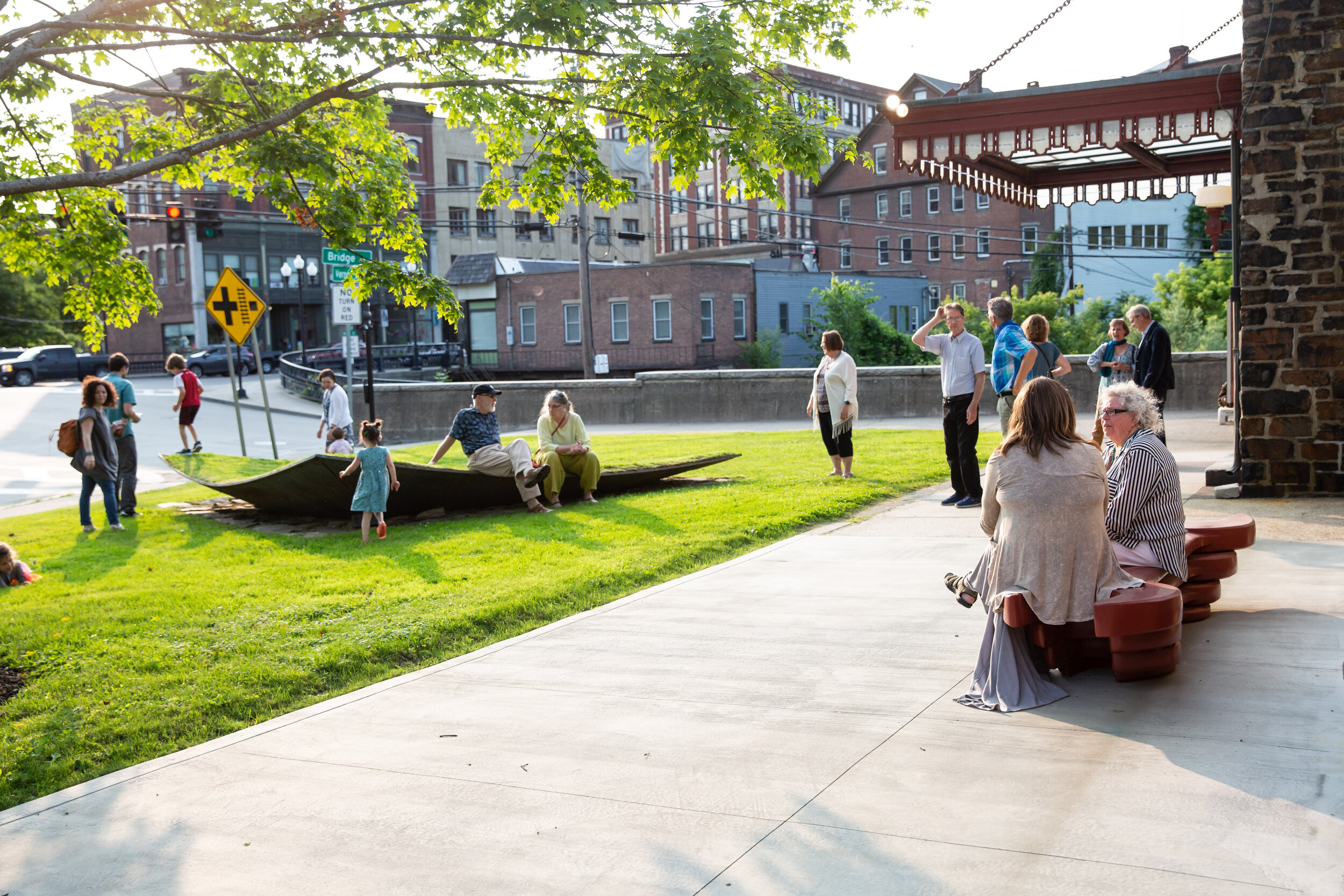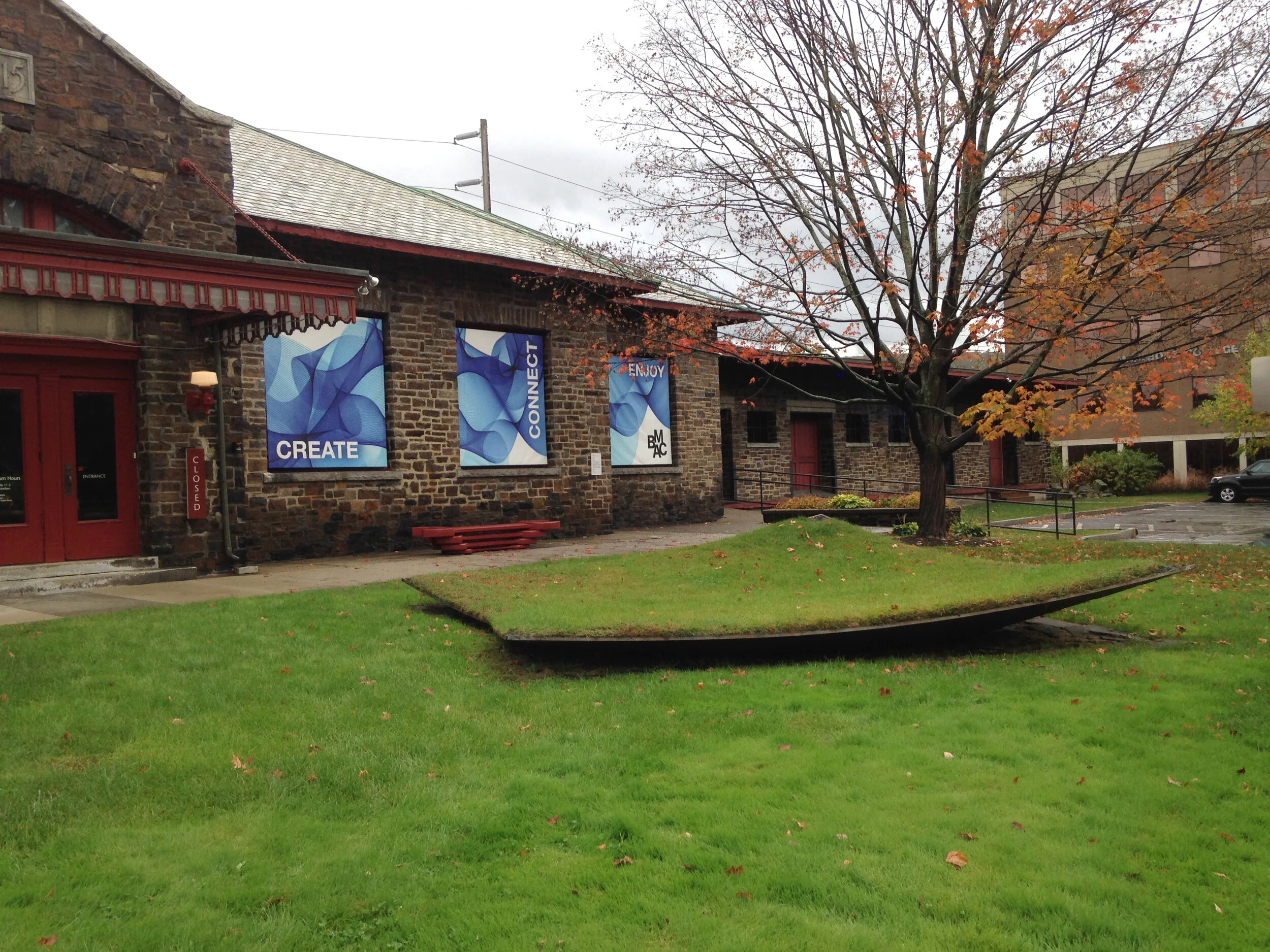“A space that somebody can find some comfort in”
Bob Boemig has been creating outdoor sculptures for museums, universities, and other institutions for over 40 years. His “Land Lift” has graced the front of the Brattleboro Museum & Art Center for the past quarter century. We spoke with Boemig this month to learn more about that piece and about how he approaches his innovative work.
Photo credit: Michelle Frehsee
BMAC: You created “Land Lift” for BMAC in 1993. Even though BMAC is a non-collecting museum, the piece is still there and is loved by Museum visitors and staff alike. BMAC Director Danny Lichtenfeld said, “It’s so well suited to the space that it would be hard—and very sad!—to imagine BMAC without it.”
What are your thoughts about the piece? Why do you think it's had such staying power?
Boemig: I invited [BMAC Chief Curator] Mara Williams over to look at the steel structure while I was working on it. I told her that I thought it would work well in front of the Museum. My main goal was to not take away from the Museum in any way by putting some 20-foot piece sticking up in front, because the building itself is so beautiful. I don’t like creating something that takes away from something else around it. I look for a spot that is less used and try to make it usable. I thought by changing the landscape a little bit, so that the ground looked as though it was being raised up almost like a magic carpet, it would be just enough of a change without being a huge statement.
And I think it does that. It gets an awful lot of use there. Kids absolutely adore it, and I’ve had many people come to me over the years to say that they played on it as a kid. It’s given me a great deal of joy, because it’s here in the town I was brought up in, and not many artists have that opportunity. There have been several directors at the Museum, and nobody seems to want to get rid of it!









BMAC: Could you talk about some of the work you've done in the years since you made “Land Lift”?
Boemig: In 2007, I did a piece called “Sisters” at the deCordova Museum, on a piece of property that nobody else would ever think of using. The sculpture is made up of three rings that work their way up a steep bank and attach themselves near an outside dining area. The land was covered with myrtle. My main goal when I do these things is to create a free-flowing entrance into something that grabs you and pulls you in without realizing that it is actually a sculpture.
A year or so before that, I created “In the Image” at the Hood Museum at Dartmouth. There was a section of the campus with two tunnels that led into a quad. People didn’t really hang out there. The pond we built in the middle of the quad was quite large, and it would reflect the sky. As you’d go through one of the tunnels, you’d hear water running, and it would echo between the buildings, and it was very soothing. There was a stairway that was all glass, and as you walked up it, you could look down into the pond. The school informed me that that was the first time that people congregated in that area. People started to use it to sun themselves, to study, because it had a very calming effect.
“In the Image” at the Hood Museum at Dartmouth
We did another one at Williams College, “Ripples.” The college was trying to draw people down to the river on the edge of campus to call attention to keeping it clean and developing trails along it. They asked me to come up with something that would be a spot where people would gather. We formed rolling hills in the shape of water rippling out if you had thrown a pebble into it. They used it for holding classrooms, meetings—I’m sure they partied on it.
I do a lot of work redesigning the flow of houses, opening them up, getting light into older houses, making them feel more homey. Sometimes you feel like a bit of a therapist, because you have brought more light into a house here in Vermont, which is needed.
BMAC: You just created a new piece for the Retreat Farm in Brattleboro.
Boemig: Yes. The Retreat Farm’s programs got shut down by the pandemic, and they were trying to figure out what they could do with their property. Danny recommended that they talk to me. I spent a couple hours with [Retreat Farm Advancement Director] Wendy Ferris one afternoon. As we walked up a hillside, I said, “Instead of installing a piece of mine, why don’t we do something you could actually use for a function?” That’s how the amphitheater came about. It’s a great place for small concerts, storytelling, yoga classes—even a great place to get married. Hopefully it will also be a nice place for people to find some solitude.
BMAC: How have you and your work have been affected by the pandemic?
Boemig: It was great that the Retreat Farm asked me to do this new piece, because it was something I could do mostly on my own. It was a good way for me to be able to get off my couch, to be quite honest with you, and do something that I don't think we’d have been able to do if Covid hadn't taken place. While I was carving out that hillside, my main thought was about all the people from the past who had worked that farm—patients from the Retreat since the 1800s going over there to find some peace, to work with the animals and on the land. I’m sure it gave people a lot of comfort.
For me, that’s what building this was all about—giving some acknowledgment to all the people who had worked the land at that farm. This spot was a hillside that was covered with stumps and bushes, a spot that I don't think anybody had thought of using, and it’s got the best view of the Retreat Meadows of any place on the campus. It’s a wonderful place for people to get out, especially during Covid.
Photo credit: Bob Boemig
BMAC: How would you describe your history with BMAC?
Boemig: The Brattleboro Museum has been terrific to me my whole life. I refer to myself as a backyard artist. I’ve never really searched out shows or opportunities for building these sculptures. Somehow—and usually it’s through the Brattleboro Museum—somebody has recommended me and I’ve been contacted. The Museum has made my life so much better by doing that. Mara has been terrific to me over the years, and Danny, and Christine Holderness. They pull together incredible shows for such a small town. We’re very lucky in Brattleboro to have them, and to have the Brattleboro Music Center, New England Youth Theater, the New England Center for Circus Arts. There are so many great artists of all sorts in these hills. Most of them, you would have no clue when meeting them how talented they are and how successful they are. That’s what's wonderful about living around here.
Years ago, I went to New York to find a gallery to sponsor me. I got involved with a gallery, and they took some of my stuff for a short time, but I could not afford to be down in New York, and it just wasn’t my cup of tea. I’m quite grateful that I stayed here in Brattleboro and experienced this place. I’ve been here pretty much all my life.
In the ’60s they were building I-91 and I-89. For me, it was such an eye-opening experience to see them contour the land and that little green stripe that goes up between north and south, crossing the state. If you look at that median strip, it kind of explains everything about my artwork—the curves in the median strip, the dips and the hollows. I have a feeling that there’s not much that affected me as a very small child more than that construction.
I had no money when I was going to school, and one day in the art studio, I looked over and saw a shovel in the ground. I said, “That’s my carving chisel from now on. I can go out and carve something in the earth, and it won’t cost me any money.” That’s how I started doing these landscape projects. So the green of Vermont has truly influenced my artwork.
What gives me a lot of joy with many of my projects is that we usually employ construction workers to drive excavators, backhoes, dump trucks. They’re usually not too thrilled about joining in at first. They think it’s a bunch of nonsense. Once we start working on the project, though, their attitude usually changes. When we have openings, they’re the first people there. They spend the whole day, they have their family with them, they’re very proud of it.
I want to bring the common New Englander into the art world in a different way. Sometimes people are sitting on my work and they don’t even realize it’s a piece of sculpture, and to me that’s great.
I don’t think there’s anything that gives me more pleasure than to see kids jumping off of “Land Lift” and running around. What I try to do is to gather people and make them feel a little better when they leave. That’s what I think public art is all about: trying to reestablish a space that somebody can find some comfort in.
Photo credit: Elizabeth Ungerleider
“Bob was one of the first artists I met after coming to the Museum thirty-plus years ago. I saw ‘Land Lift’ in development at his studio and was immediately drawn to its elegant lines and the interplay of positive and negative space. It had the effect of an exhalation—a simple, life-affirming sigh. It wasn't until the Museum's family party on opening day in 1993 that the children of Brattleboro showed me that ‘Land Lift’ was in fact a magic carpet. After all these years, I'm still delighted by the sculpture—so much so that I had Bob install a circular bowl of grass titled ‘Lift’ at my home.”
—Mara Williams, BMAC Chief Curator















